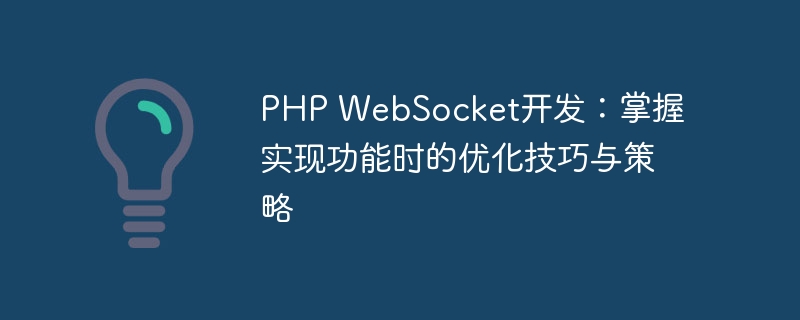

PHP WebSocket is a web-based real-time communication protocol that enables the server to communicate with the client in two-way in real time. Compared with the traditional HTTP protocol, WebSocket has the advantages of high efficiency, low latency and less resource consumption. In today's fast-paced Internet era, real-time communication is crucial for many application scenarios. When developing WebSocket applications, we need to master some optimization techniques and strategies to improve the performance and stability of the application.
First, we can start by designing the architecture of the WebSocket application. Reasonable architectural design can improve the scalability and maintainability of the system. When designing, we can use multi-process or multi-threading to handle concurrent requests. This can make full use of server resources and better cope with high concurrency situations. In addition, using a load balancer is also a good choice, which can distribute requests to different servers to further improve system performance and availability.
Secondly, optimizing database access is an important part of developing WebSocket applications. In real-time communication, frequent reading and writing of the database are often required. In order to improve query performance, we can use index optimization, partition tables, caching and other means. In addition, it is also important to choose a database engine reasonably. For example, using Redis as a cache database can greatly improve access speed.
In addition, for front-end development of WebSocket applications, reducing network load is also an important optimization strategy. We can reduce the size of front-end files by compressing HTTP requests, merging CSS and JavaScript files, and using CDN. In addition, in front-end development, caching static resources to the client to reduce repeated loading is also a good choice.
For performance bottlenecks, we can use Profiling tools to analyze the code, find where the performance bottlenecks are, and then take corresponding optimization measures. For example, we can optimize frequently executed code to reduce its running time. Reasonable use of cache is also a common optimization method. We can cache commonly used data or calculation results and use the cache directly on the next request to avoid unnecessary calculations or database queries.
In addition, handling exceptions and errors in a timely manner is also something that needs to be paid attention to when developing WebSocket applications. When an exception occurs, we should record logs and handle errors in a timely manner to avoid the application crashing due to exceptions. In addition, for some time-consuming operations, we can use asynchronous processing to improve the throughput of the system.
Finally, performance testing and stress testing are also important means to optimize WebSocket applications. We can use some performance testing tools, such as Apache Bench or JMeter, to simulate high concurrency scenarios and test the performance and stability of the system. Through testing, we can find the bottlenecks of the application and make targeted optimizations based on the test results.
To sum up, mastering the optimization skills and strategies when implementing functions is an important part of developing WebSocket applications. Reasonable architectural design, optimized database access, front-end performance optimization, code optimization, error handling, and performance testing can all help us improve the performance and stability of our applications. Through continuous optimization and iteration, we can create more efficient and reliable WebSocket applications.
The above is the detailed content of PHP WebSocket development: Master optimization techniques and strategies when implementing functions. For more information, please follow other related articles on the PHP Chinese website!




